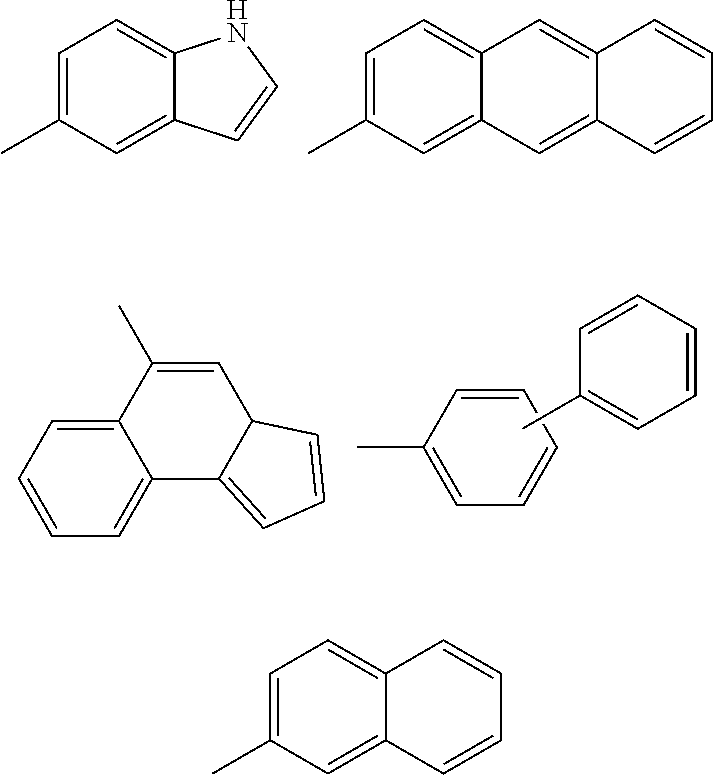Inhibitors of Protein Tyrosine Kinase Activity
a technology of protein tyrosine kinase and inhibitors, which is applied in the direction of plant growth regulators, biocide, animal husbandry, etc., can solve problems such as vision loss, and achieve the effects of inhibiting protein tyrosine kinase activity, and inhibiting kinase activity
- Summary
- Abstract
- Description
- Claims
- Application Information
AI Technical Summary
Benefits of technology
Problems solved by technology
Method used
Image
Examples
example 5
4-((6-(7-(2-(4-Chlorophenylamino)benzo[d]oxazol-5-yloxy)thieno[3,2-b]pyridin-2-yl)pyridin-3-yl)methyl)amino-N-(2-(diethylamino)ethyl)benzamide (16, example 5)
[0306]To a suspension of aldehyde 8 (0.178 g, 0.357 mmol), the amine salt 0.147 g, 0.541 mmol) and the dibutyltin dichloride (0.197 g, 0.648 mmol) in DMF was added phenylsilane (0.047 g, 0.434 mmol). The suspension became a solution and the reaction mixture was stirred for 2.5 hours. The reaction mixture was then poured into a mixture of brine / saturated NaHCO3 solution and the resultant precipitate was collected by filtration and dried. The dry material was absorbed on silica gel and purified by flash column chromatography, eluent MeOH (16%) in DCM (methanol contained 2% ammonia), to afford title compound 16 (0.134 g, 52.3%). Characterization of 16 is provided in the table 2.
[0307]Compounds 17-20 (examples 6-8) were prepared starting from aldehyde 8 and using the procedure similar to the one described above for the synthesis of...
example 9
N-(4-Chlorophenyl)-5-(2-(5-((((1-ethyl-1H-1,2,3-triazol-4-yl)methyl)(isopropyl)amino)methyl)pyridin-2-yl)thieno[3,2-b]pyridin-7-yloxy)benzo[d]oxazol-2-amine (21, example 9)
Step 1: N-(4-Chlorophenyl)-5-(2-(5-((prop-2-ynylamino)methyl)pyridin-2-yl)thieno[3,2-b]pyridin-7-yloxy)benzo[d]oxazol-2-amine (20)
[0308]To a solution of 8 (215 mg, 0.431 mmol) in DMF (3 mL) was added propargyl amine (35.6 mg, 1.5 eq, 0.646 mmol), dibutyltin dichloride (157 mg, 1.2 eq, 0.517 mmol) and phenylsilane (84 mg, 1.8 eq, 0.776 mmol). The reaction mixture was stirred at RT overnight, diluted with EtOAc and washed with water. The organic phase was, dried over anhydrous MgSO4, filtered and concentrated. Purification by column chromatography (EtOAc to 20% MeOH in EtOAc) afforded 20 (170 mg, 73%) as a white solid. MS (m / z)=539.12 / 541.12 (M+H).
Step 2: N-(4-Chlorophenyl)-5-(2-(5-((((1-ethyl-1H-1,2,3-triazol-4-yl)methyl)(isopropyl)amino)methyl)pyridin-2-yl)thieno[3,2-b]pyridin-7-yloxy)benzo[d]oxazol-2-amine (21, e...
example 10
1-((6-(7-(2-(4-Chlorophenylamino)benzo[d]oxazol-5-yloxy)thieno[3,2-b]pyridin-2-yl)pyridin-3-yl)methyl)pyrrolidin-2-one (46)
[0321]To hydroxylbenzoxazole 5 (156 mg, 0.60 mmol), chloride 36 (103 mg, 0.30 mmol) and KOtBu (79 mg, 0.70 mmol) was added anhydrous DMSO (3.0 mL) at room temperature under the argon atmosphere. The reaction was stirred for 30 min at room temperature then for 2 h at 80° C. The reaction was quenched with water at room temperature to form a precipitate that was collected by filtration and dried. The material was purified by column chromatography (NH silica, CH2Cl2 / MeOH=100 / 0-90 / 5), to afford compound 46 (20 mg, 12% yield) as a colorless solid. 1H-NMR (CDCl3) δ (ppm): 8.54 (d, J=1.8 Hz, 1H), 8.48 (d, J=5.7 Hz, 1H), 8.00 (s, 1H), 7.86 (d, J=7.8 Hz, 1H), 7.72 (dd, J=7.8, 2.1 Hz, 1H), 7.62-7.58 (m, 2H), 7.40-7.33 (m, 4H), 7.18 (brs, 1H), 7.00 (dd, J=8.7, 2.4 Hz, 1H), 6.58 (d, J=5.7 Hz, 1H), 4.52 (s, 2H), 3.33 (dd, J=7.8, 7.2 Hz, 2H), 2.47 (dd, J=8.4, 7.8 Hz, 2H), 2.10...
PUM
| Property | Measurement | Unit |
|---|---|---|
| enantiomeric excess | aaaaa | aaaaa |
| temperature | aaaaa | aaaaa |
| temperature | aaaaa | aaaaa |
Abstract
Description
Claims
Application Information
 Login to View More
Login to View More - R&D
- Intellectual Property
- Life Sciences
- Materials
- Tech Scout
- Unparalleled Data Quality
- Higher Quality Content
- 60% Fewer Hallucinations
Browse by: Latest US Patents, China's latest patents, Technical Efficacy Thesaurus, Application Domain, Technology Topic, Popular Technical Reports.
© 2025 PatSnap. All rights reserved.Legal|Privacy policy|Modern Slavery Act Transparency Statement|Sitemap|About US| Contact US: help@patsnap.com



